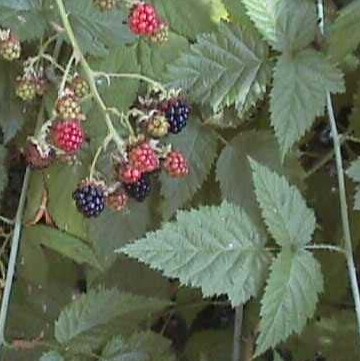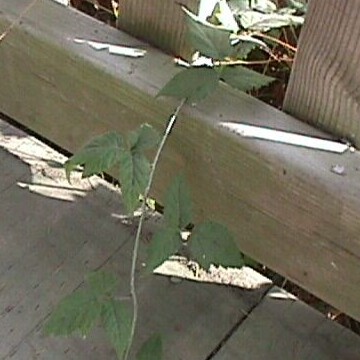

General species Description
- Trailing blackberry is a native perennial, low trailing shrub. Its trailing or climbing stem is armed with tiny, slender, hooked spines. This species produces male and female flowers borne on separate plants that are white or pink with elongated petals. Both flowers are five petaled. Trailing blackberry produces edible berries in open, sunny areas from April to August.
Leaves
- The leaves of trailing blackberry are deciduous, alternate in leaf arrangement, and composed of three leaflets. The leaflets are 3-7 cm long, the terminal leaflet 3-lobed. Leaf margins are sharply toothed and the stems and veins are prickly; stipules various but usually slender or joined to the leaf stalks. The color of the leaves are dark green above, with a pale white-green underneath .
Inflorescence/Flowers
- Trailing blackberry produces large white or pink flowers ( to 4 cm across ); in flat-topped purplish-hued clusters from the leaf axis; male and female flowers are separate plants. The female flowers have distinct rudimentary stamens, the male with small, non-functional ovaries. Blooming time is April through August.
Fruits
- Trailing blackberry produces a hanging berry that is up to 1 cm long. The blackberry is composed of an aggregation of drupes. The color of the berries are deep red to shiny black. The fruits are of same general shape and character as loganberries and boysenberries, but smaller in size. The fruits are edible, sweet, juicy, and fleshy.
Habitat
- Trailing blackberry is often found in fairly open to dense woods. It appears to thrive in clear-cuts, fire scars, logged-one areas and under transmission lines. It is also commonly found next to or intertwined with Rubus Procerus, the Himalayan blackberry.
Range
- British Columbia to Northern California, from the Coast to middle elevations in the mountains, and east of Central Idaho. Trailing blackberry also occurs in all Western Washington and Northwest Oregon Counties, but is restricted to the southwestern corner of the Province and South Vancouver.
Similar Species
- Trailing blackberry is variable in form and color. Himalayan blackberry can be distinguished by its smaller flowers ( 2-3 cm across ), erect and archy stems, and its 3-5 oval leaflets with whitew hairs. Blackcap ( Rubus leucodermis ) a less common native, can be distinguished by its paler green-blue erect stems, purple fruits, and leaves that have fine white hairs underneath.
Habitat
Trailing blackberry is prevalent and abundant on disturbed sites, at low to middle elevations. It also can behave as a weed in some suburban and rural areas. Because the fruit of trailing blackberry is at ground level, it is a important food source for a variety of birds and mammals.
Human Value
- The vines of trailing blackbery were used by the Saanish Indians of Vancouver Island to place over and under food in steam cooking pits, and also for ritual scrubbing. They and other Coast Salish groups sometimes used the fruits as a purple stain. The berries were eaten fresh, or mashed and dried in cakes, by the Straits Salish, Halkomelen, Squamish, Sechelt, Comex, Nootka, and South Kwakiutt. Other indian uses include: using the leaves and roots to treat diarrhea, dysentary, cholera, excessive menstruation, fever, and sores in the mouth. The leaves of this species also were used as a substitution for tea during the Colonial Tea Boycott. Currently, teas made from this species are recommended by herbalists as a diuretic and mild astringent. In addition, the seeds of drupes all contain Cyanogenic Glycosides. The leaves of Cyanogenic plants were boiled and used as a bitter tonic and astringent, and presently is an ingredient in an assortment of Patent medicines.
References
- Altonen B.L., 1993. Ethnopharmacology. Portland, Oregon
Cooke, S. S., ed. 1997. A Field Guide to the Common Wetland Plants of Western Washington & Northwest Oregon. Seattle Audubon Society and Washington Native Plant Society. Seattle Audubon Society, Seattle WA, 78pp.
Turner, N.J. 1979. Plants in British Columbia Indian Technology. Handbook #38. British Columbia Provincial Museum, Victoria, British Columbia.
This page was created by: Kirsten Johnson, August 2000
Return to Northwest Oregon Wetland Plants Project